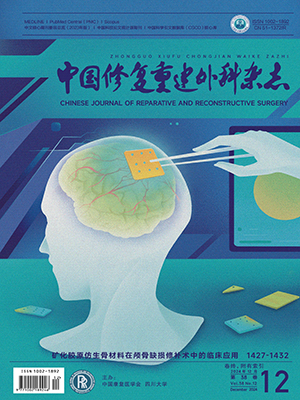| 1. |
Li Q, Wang Z. Influence of mesenchymal stem cells with endothelial progenitor cells in co-culture on osteogenesis and angiogenesis:an in vitro study. Arch Med Res, 2013, 44(7) :504-513.
|
| 2. |
Schumann P, Lindhorst D, von See C, et al. Accelerating the early angiogenesis of tissue engineering constructs in vivo by the use of stem cells cultured in matrigel. J Biomed Mater Res A, 2014, 102(6) :1652-1662.
|
| 3. |
Yamada A, Yokoo T, Yokote S, et al. Comparison of multipotency and molecular profile of MSCs between CKD and healthy rats. Hum Cell, 2014, 27(2) :59-67.
|
| 4. |
王福科,刘流,李彦林,等.骨髓基质干细胞与PDPB体外构建组织工程骨的适宜条件.中国组织工程研究与临床康复, 2008, 12(33) :6401-6405.
|
| 5. |
赵娴.自体外周血EPCs与BMSCs联合PDPB构建微血管化生物骨.昆明:昆明医科大学, 2013.
|
| 6. |
幸嵘,孔清泉,项舟,等.小鼠干细胞成骨和成软骨分化特异性微小RNA的初步研究.中国修复重建外科杂志, 2014, 28(8) :1009-1016.
|
| 7. |
晏开力,汪健,李庆,等.成人骨髓间充质干细胞分化为血管内皮细胞的研究.中国修复重建外科杂志, 2007, 21(1) :76-80.
|
| 8. |
Song X, Liu S, Qu X, et al. BMP2 and VEGF promote angiogenesis but retard terminal differentiation of osteoblasts in bone regeneration by up-regulating Id1. Acta Biochim Biophys Sin (Shanghai), 2011, 43(10) :796-804.
|
| 9. |
Lindhorst D, Tavassol F, von See C, et al. Effects of VEGF loading on scaffold-confined vascularization. J Biomed Mater Res A, 2010, 95(3) :783-792.
|
| 10. |
Martin JR, Gupta MK, Page JM, et al. A porous tissue engineering scaffold selectively degraded by cell-generated reactive oxygen species. Biomaterials, 2014, 35(12) :3766-3776.
|
| 11. |
Ebrahim NA, Leach L. Temporal studies into attachment, VE-cadherin perturbation, and paracellular migration of human umbilical mesenchymal stem cells across umbilical vein endothelial monolayers. Stem Cells Dev, 2015, 24(4) :426-436.
|
| 12. |
王伟,刘德红,李卓成,等.转染VEGF基因对内皮祖细胞生长的影响研究.中国实验诊断学, 2015, 19(3) :355-358.
|
| 13. |
Menge T, Gerber M, Wataha K, et al. Human mesenchymal stem cells inhibit endothelial proliferation and angiogenesis via cell-cell contact through modulation of the VE-Cadherin/β-catenin signaling pathway. Stem Cells Dev, 2013, 22(1) :148-157.
|
| 14. |
Nassiri SM, Rahbarghazi R. Interactions of mesenchymal stem cells with endothelialcells. Stem Cells Dev, 2014, 23(4) :319-332.
|
| 15. |
Huang S, He P, Peng X, et al. Pristimerin Inhibits Prostate Cancer Bone Metastasis by Targeting PC-3 Stem Cell Characteristics and VEGF-Induced Vasculogenesis of BM-EPCs. Cell Physiol Biochem, 2015, 37(1) :253-268.
|
| 16. |
Su CH, Wu YJ, Chang CY, et al. The increase of VEGF secretion from endothelial progenitor cells post ultrasonic VEGF gene delivery enhances the proliferation and migration of endothelial cells. Ultrasound Med Biol, 2013, 39(1) :134-145.
|
| 17. |
Xue J, Du G, Shi J, et al. Combined treatment with erythropoietin and granulocyte colony-stimulating factor enhances neovascularization and improves cardiac function after myocardial infarction. Chin Med J (Engl), 2014, 127(9) :1677-1683.
|
| 18. |
Raida M, Heymann AC, Günther C, et al. Role of bone morphogenetic protein 2 in the crosstalk between endothelial progenitor cells and mesenchymal stem cells. Int J Mol Med, 2006, 18(4) :735-739.
|
| 19. |
He X, Dziak R, Yuan X, et al. BMP2 genetically engineered MSCs and EPCs promote vascularized bone regeneration in rat critical-sized calvarial bone defects. PLoS One, 2013, 8(4) :e60473.
|
| 20. |
温丽.血管内皮祖细胞对大鼠骨髓间充质干细胞生物学特性调控作用的研究.西安:第四军医大学, 2013.
|
| 21. |
Pusztaszeri MP, Seelentag W, Bosman FT, et al. Immunohistochemical expression of endothelial markers CD31, CD34, von Willebrand factor, and Fli-1 in normal human tissues. J Histochem Cytochem, 2006, 54(4) :385-395.
|




